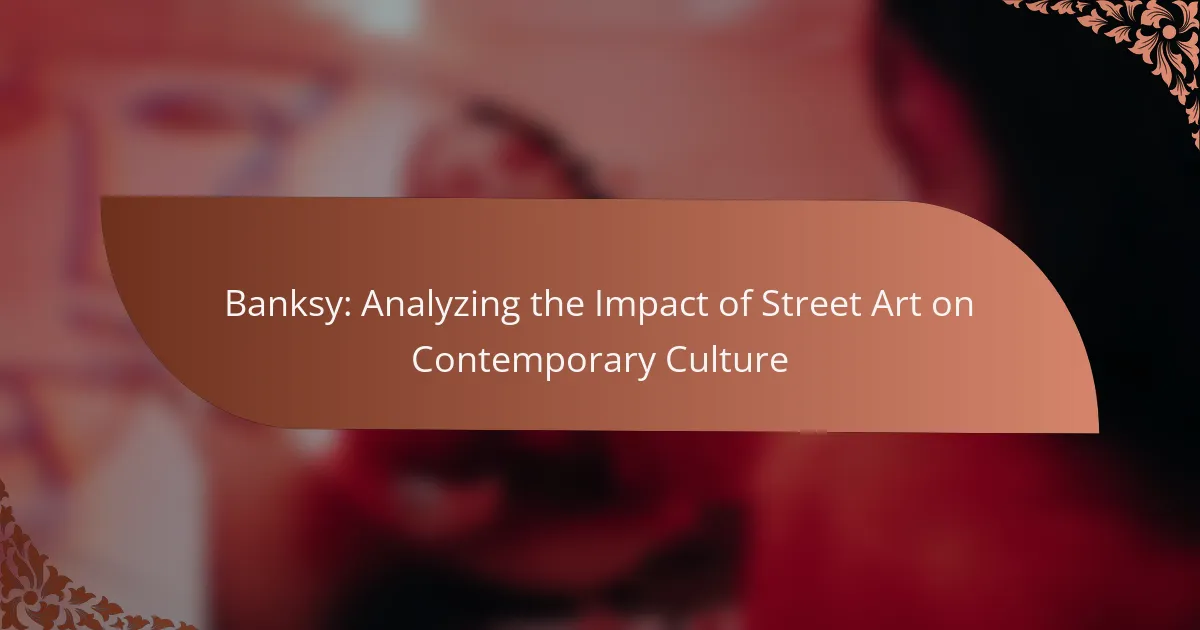Banksy’s street art serves as a powerful commentary on contemporary culture, challenging societal norms and sparking dialogue about critical issues. His anonymity enhances the allure of his work, allowing audiences to focus on the message rather than the artist. Through techniques like stenciling and satire, Banksy’s art critiques consumerism, war, and inequality. This influence extends to both the street art movement and commercial markets, raising questions about authenticity and artistic intent.
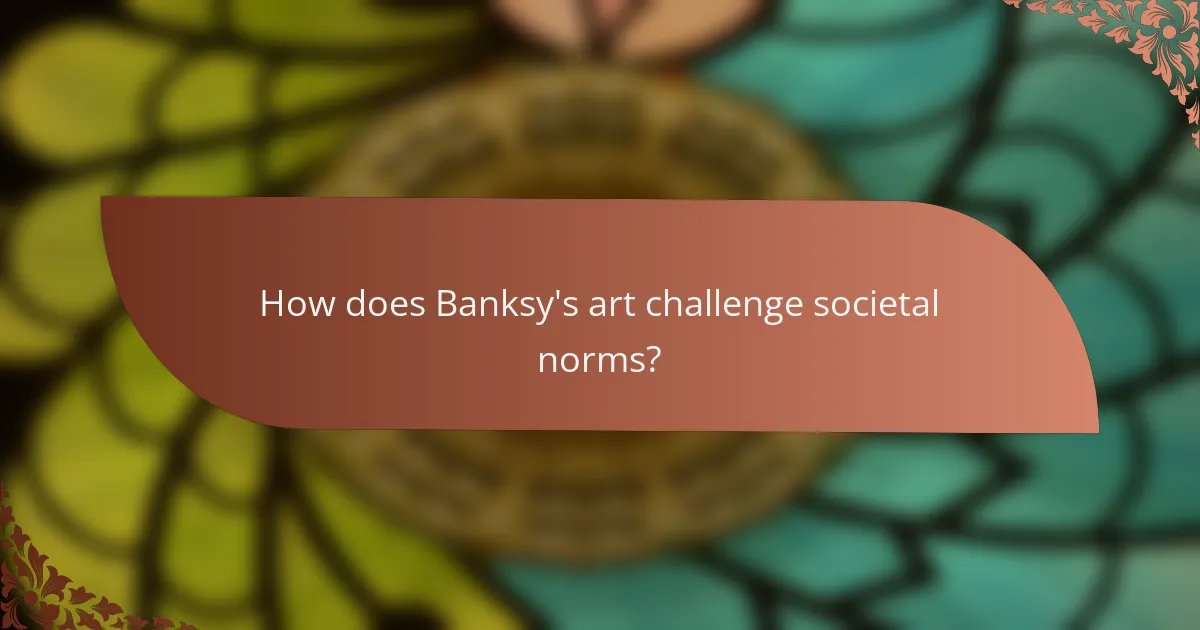
How does Banksy’s art challenge societal norms?
Banksy’s art challenges societal norms by provoking thought and sparking dialogue about critical issues. His work often critiques consumerism, war, and inequality, using humor and satire to engage audiences. For example, his piece “Girl with a Balloon” symbolizes lost innocence, prompting reflections on hope and despair. Banksy’s anonymity adds a unique layer, emphasizing the message over the artist’s identity. This approach disrupts traditional art values, making art accessible and relevant to the public. As a result, Banksy’s art serves as a powerful tool for social commentary and change.
What themes are prevalent in Banksy’s work?
Banksy’s work often explores themes of social justice, anti-establishment sentiment, and political commentary. His art critiques consumerism, war, and environmental issues, reflecting contemporary societal concerns. For example, pieces like “Girl with a Balloon” symbolize hope amid despair, while “The Flower Thrower” advocates for peace through non-violent resistance. Additionally, Banksy’s use of humor and irony challenges viewers to reflect on their beliefs and the status quo. His unique ability to provoke thought through accessible street art has made a significant impact on contemporary culture.
How does Banksy use satire in his street art?
Banksy uses satire in his street art to critique social and political issues. His work often combines humor and irony, making powerful statements about consumerism, war, and authority. For example, his piece “Girl with a Balloon” juxtaposes innocence with loss, highlighting societal neglect. This unique approach engages viewers, prompting reflection on contemporary culture. Banksy’s art serves as a rare commentary that challenges norms and encourages dialogue.
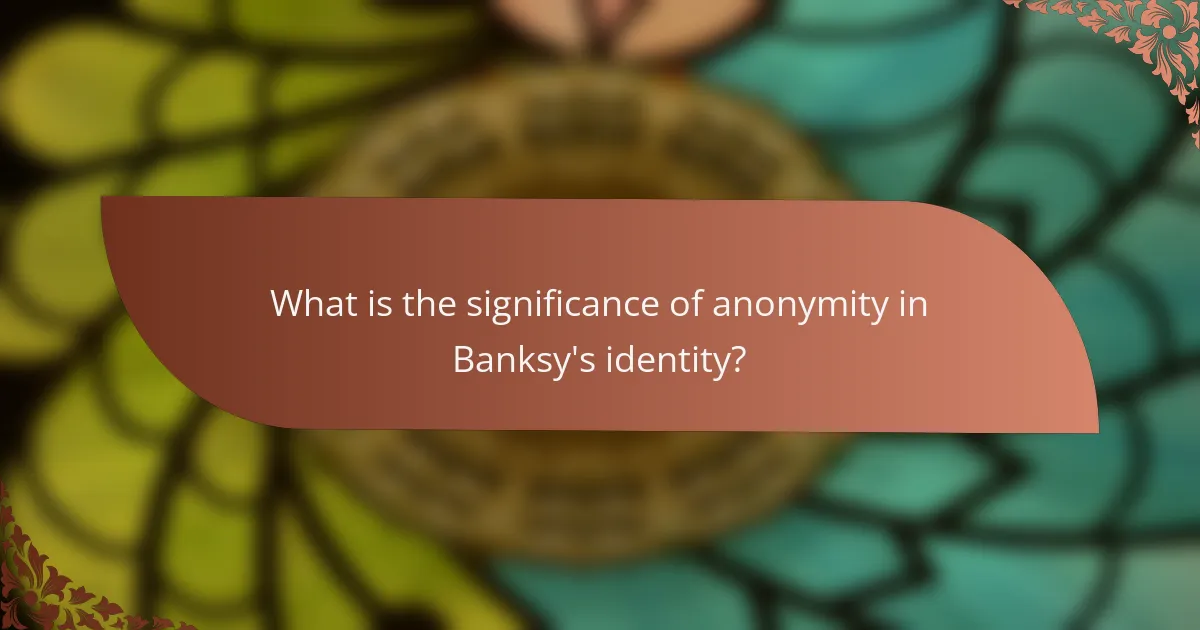
What is the significance of anonymity in Banksy’s identity?
Anonymity is significant in Banksy’s identity as it enhances the allure and mystique of his artwork. This obscurity allows viewers to focus on the message rather than the artist, fostering a deeper connection with the themes of social commentary and political critique. Banksy’s anonymity also protects him from commercial exploitation, ensuring his art remains accessible and relevant to the public. This unique attribute of being an anonymous artist in the street art movement has contributed to his status as a cultural icon, influencing contemporary art and activism.
Why does Banksy choose to remain anonymous?
Banksy remains anonymous to maintain artistic freedom and protect his identity. This anonymity allows him to critique societal issues without facing legal repercussions. Additionally, it enhances the allure of his work, creating a mystique that captivates audiences. By remaining unseen, Banksy fosters a focus on his art rather than his personal life, emphasizing the message over the messenger.
How does anonymity affect the perception of his art?
Anonymity enhances the perception of Banksy’s art by creating intrigue and mystique. This anonymity allows viewers to focus more on the message and social commentary rather than the artist’s identity. As a result, his work often sparks discussions about societal issues without the bias of personal fame influencing interpretation. The unique attribute of anonymity contributes to the allure of his pieces, making them iconic in contemporary culture.
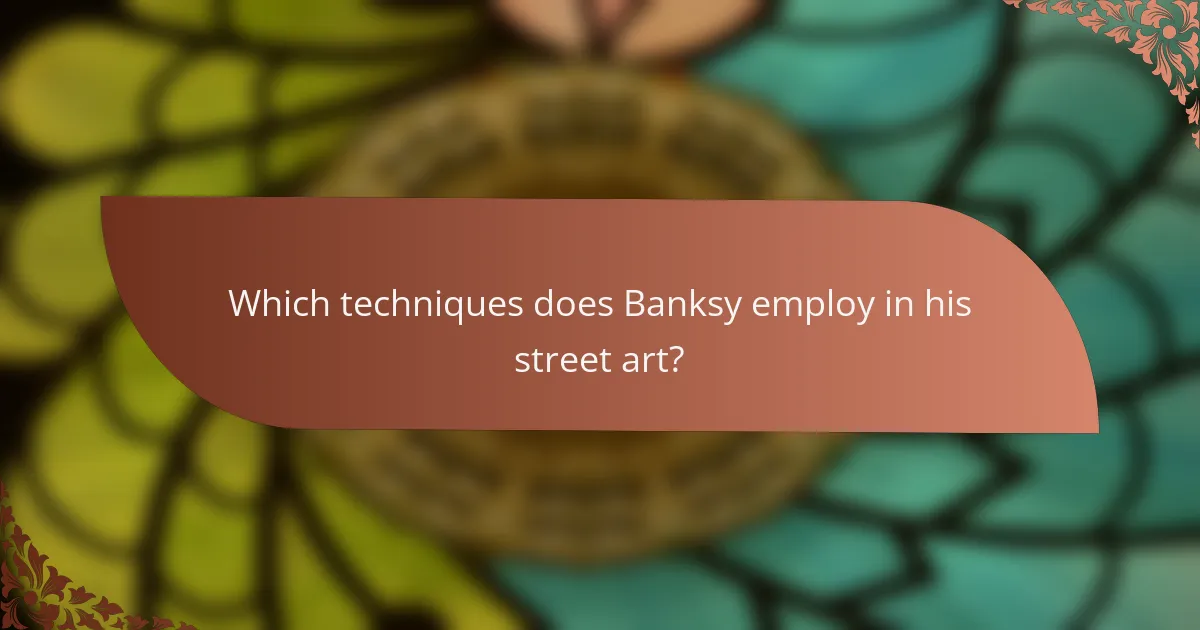
Which techniques does Banksy employ in his street art?
Banksy employs techniques such as stenciling, satire, and social commentary in his street art. His use of stencils allows for quick execution and replication, making his art accessible. Satire is a hallmark of his work, often critiquing social and political issues. This blend of humor and poignant messaging resonates with contemporary culture, challenging viewers to reflect on societal norms. Additionally, Banksy’s unique ability to integrate his art within specific urban contexts enhances its impact and relevance.
What are the most common mediums used by Banksy?
Banksy commonly uses stencils, spray paint, and mixed media in his artwork. Stencils allow for quick execution and replicate his signature style. Spray paint serves as a versatile medium for vibrant colors and intricate designs. Mixed media incorporates various materials, enhancing the depth and message of his pieces.
How does Banksy’s technique contribute to the message of his art?
Banksy’s technique enhances his art’s message through irony, satire, and social commentary. His use of stencils allows for rapid execution, enabling timely responses to current events. This immediacy amplifies the impact of his commentary on societal issues. Additionally, his choice of public spaces ensures accessibility, inviting diverse audiences to engage with his work. The juxtaposition of playful imagery with serious themes creates a thought-provoking contrast, encouraging viewers to reflect on the underlying messages.
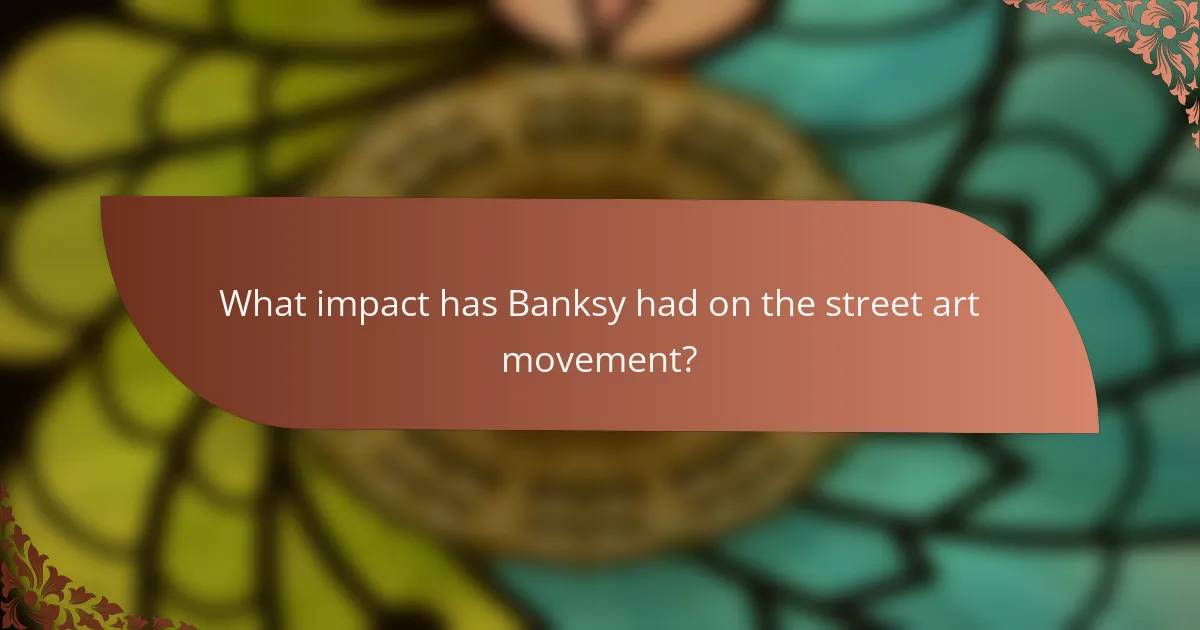
What impact has Banksy had on the street art movement?
Banksy has profoundly influenced the street art movement by elevating it to global recognition and challenging societal norms. His work often critiques political issues, consumerism, and war, prompting public discourse. Banksy’s unique style combines humor with poignant messages, making art accessible to a wider audience. As a result, he has inspired countless artists and revitalized urban spaces, transforming them into platforms for social commentary.
How has Banksy influenced emerging street artists?
Banksy has significantly influenced emerging street artists by inspiring them to challenge societal norms. His provocative style encourages a blend of art and activism, motivating new artists to use public spaces for political statements. The anonymity he maintains fosters a sense of mystery, leading many to adopt similar tactics to create intrigue around their identities. Additionally, Banksy’s ability to generate widespread media attention demonstrates the power of street art in contemporary culture, prompting emerging artists to pursue visibility through innovative techniques. This alignment with social issues and community engagement has become a hallmark of the new generation of street artists.
What role does Banksy play in legitimizing street art as a form of fine art?
Banksy plays a crucial role in legitimizing street art as fine art through his unique style and social commentary. His works challenge traditional art norms, sparking conversations about authenticity and value in art. Banksy’s anonymity adds intrigue, making his pieces highly sought after in galleries and auctions. This shift has led to increased recognition of street art as a legitimate art form, influencing both artists and collectors alike. As a result, street art is now more widely accepted within the contemporary art scene, blurring the lines between public space and gallery exhibitions.
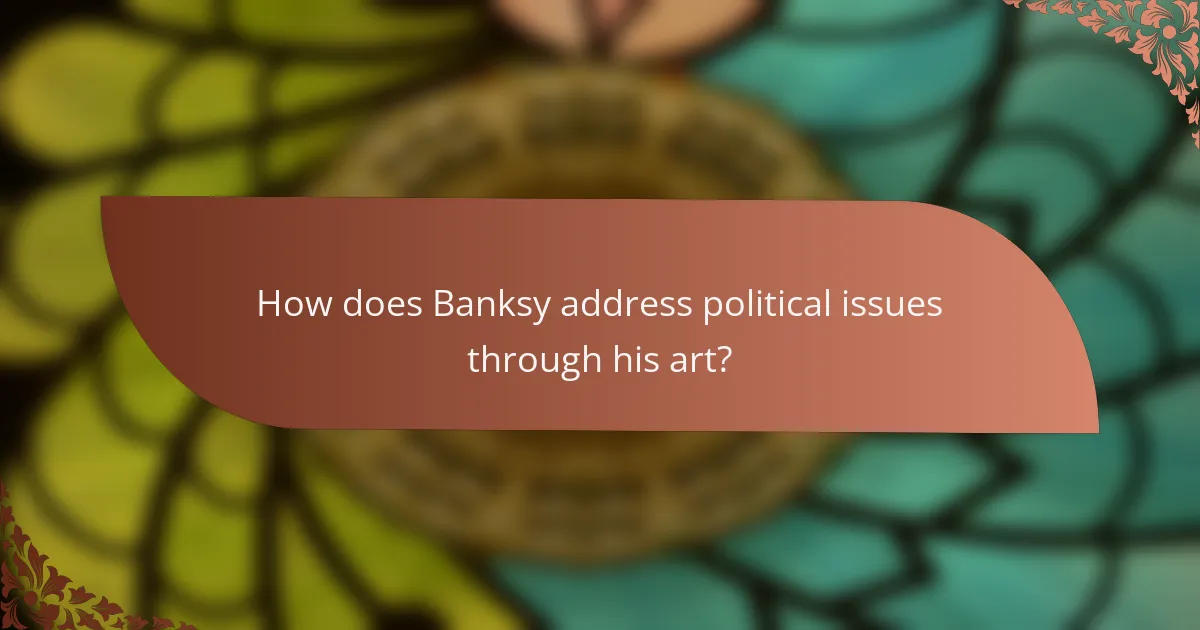
How does Banksy address political issues through his art?
Banksy addresses political issues through his art by using satire and visual metaphors. His works often critique government policies, social injustices, and consumerism, engaging viewers in critical dialogue. For instance, pieces like “Girl with Balloon” symbolize hope amidst despair, while “The Flower Thrower” advocates for peace over violence. Banksy’s anonymity adds intrigue, allowing his messages to resonate across diverse audiences. Through public installations, he democratizes art, making it accessible and relevant to contemporary societal issues.
Which political messages are most prominent in Banksy’s works?
Banksy’s works prominently convey political messages centered around anti-establishment sentiments, social justice, and human rights. His art critiques capitalism, war, and government authority, often using satire and humor. For example, the piece “Girl with a Balloon” symbolizes hope amidst despair, while “The Flower Thrower” promotes non-violent protest. Banksy’s unique ability to blend art with activism amplifies his political commentary, making it resonate with a broad audience. His rare use of public spaces challenges traditional notions of art ownership and accessibility, further emphasizing his political stance.
How do different cultures interpret Banksy’s political commentary?
Different cultures interpret Banksy’s political commentary through their unique social, historical, and political lenses. For instance, in the UK, his work often critiques consumerism and government policies, resonating with local social movements. In contrast, Middle Eastern audiences may focus on themes of conflict and resistance, reflecting their political struggles. Cultural context shapes the reception of his art, influencing how messages of dissent and activism are understood. This variability highlights Banksy’s unique ability to engage with diverse audiences, making his work globally relevant while rooted in specific cultural dialogues.
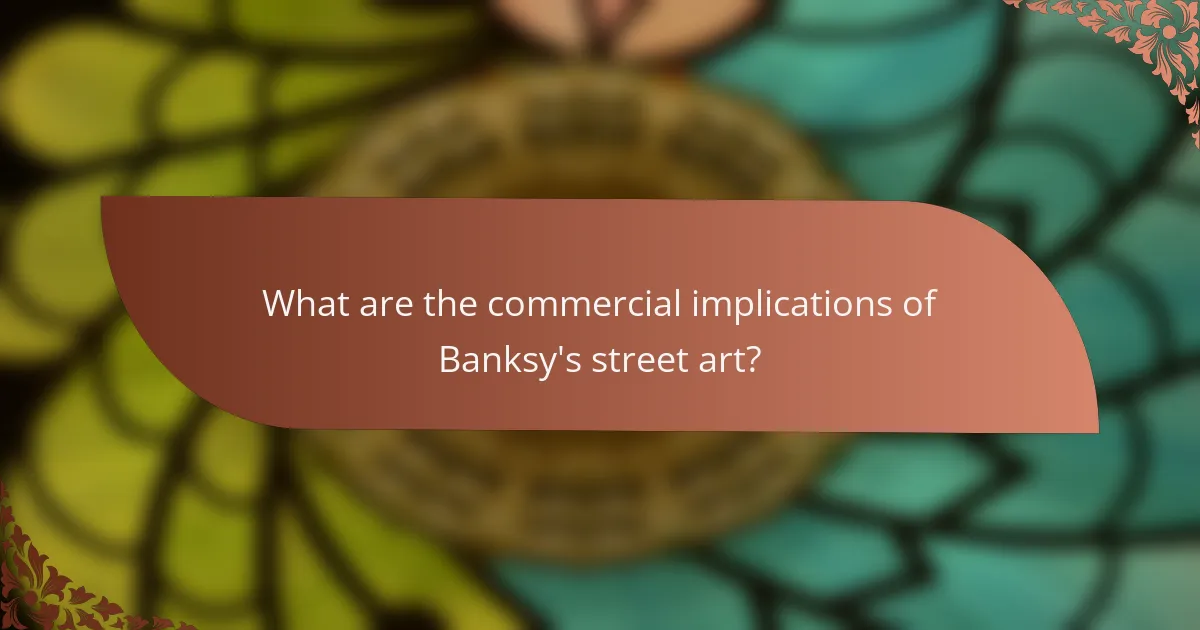
What are the commercial implications of Banksy’s street art?
Banksy’s street art significantly influences commercial markets by elevating art’s cultural value. His works challenge traditional art sales, creating a unique intersection of street culture and consumerism. The scarcity of his pieces often leads to inflated auction prices, reflecting high demand. Additionally, brands leverage his imagery for marketing, enhancing their appeal through association with his provocative themes. This commercialization raises questions about authenticity and artistic intent, making Banksy a pivotal figure in discussions on art’s role in society.
How does the art market respond to Banksy’s pieces?
The art market reacts to Banksy’s pieces with significant interest and value appreciation. His works often challenge societal norms and provoke discussions, leading to high auction prices. For instance, a piece sold for over $1.4 million, illustrating the unique demand for his art. Additionally, Banksy’s ability to engage with contemporary issues enhances his relevance, making his art a focal point in galleries and exhibitions worldwide. The rarity of his original pieces further amplifies their market value, creating a dynamic interplay between street art and traditional art markets.
What are the controversies surrounding the commercialization of street art?
The commercialization of street art, particularly Banksy’s work, raises significant controversies. Critics argue that it undermines the original intent of street art as a form of social commentary and rebellion. The transformation of art into commodities can dilute its message, turning it into a product for profit rather than a voice for the marginalized. Additionally, the involvement of galleries and auction houses often leads to the exploitation of artists, with profits rarely benefiting the creators. This tension between artistic integrity and commercial interests continues to provoke debate within contemporary culture.
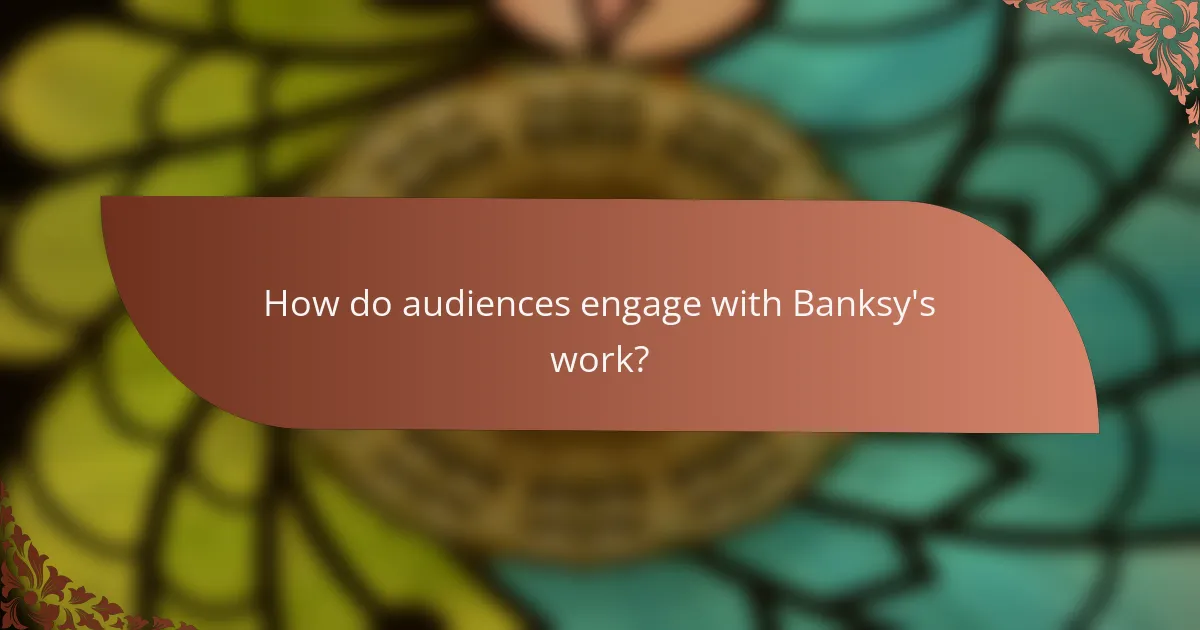
How do audiences engage with Banksy’s work?
Audiences engage with Banksy’s work through emotional responses, social commentary, and interactive experiences. His art often provokes thought and discussion, challenging societal norms. The anonymity of Banksy enhances intrigue, prompting viewers to seek deeper meanings. Additionally, social media amplifies engagement, allowing fans to share and interpret his pieces widely.
What are the common reactions to Banksy’s installations?
Common reactions to Banksy’s installations include admiration, controversy, and debate. Many viewers appreciate the social commentary and artistic skill, while others criticize the legality and ethics of street art. Some installations provoke strong emotional responses, sparking discussions about societal issues. Banksy’s ability to challenge norms often leads to polarized opinions, reflecting the unique attributes of his work that resonate differently with diverse audiences.
How does social media influence the reception of Banksy’s art?
Social media significantly shapes how audiences perceive Banksy’s art. Platforms like Instagram and Twitter amplify visibility, allowing for rapid sharing and discussion. This instant feedback influences public opinion and can elevate art from street corners to global conversations. Additionally, social media enables direct engagement between Banksy and his audience, fostering a community that interprets and critiques his work collectively. The viral nature of posts can also affect the value and interpretation of specific pieces, showcasing how digital interactions redefine contemporary art reception.
What are the best practices for experiencing Banksy’s art?
To experience Banksy’s art effectively, engage with it in its urban context. Seek out locations where his pieces are displayed, as the environment enhances their meaning. Participate in guided street art tours that provide insights into his work and its socio-political commentary. Document your experience through photography, but respect the integrity of the art and surrounding space. Lastly, follow Banksy’s social media for updates on new installations and exhibitions, which often reveal the evolving nature of his projects.
